Apple iPhone 6 And iPhone 6 Plus Review
The iPhone 6 and 6 Plus are bigger and better than ever, but are they a worthy upgrade for existing iPhone users? What if you previously passed over the iPhone because of its small screen, does it now merit a second look?
Why you can trust Tom's Hardware
Camera: Photo Quality
Still Image Quality
In order to evaluate image quality, I took a variety of pictures under different lighting conditions. All pictures were taken with the native camera app using default or automatic settings.
Pictures from the iPhone 6 Plus (iOS 8.0.2) are compared with those from the iPhone 5s (iOS 7) and the Samsung Galaxy Note 4. Even though the camera hardware in the iPhone 6 and iPhone 5s is very similar, there appears to be some software differences between iOS 7 and iOS 8 that affects white balance and purple chromatic aberrations in certain lighting conditions, negatively affecting the iPhone 6’s picture quality. The use of local tone mapping can also cause aberrations in certain situations.
The pictures from the Galaxy Note 4 have a 16:9 aspect ratio, whereas the iPhone captures images in 4:3. Since our picture album feature also requires a 4:3 aspect ratio, the Note 4 pictures are cropped. Also, the comparison pictures were resized to fit within the bounds of our picture album, which affects image quality by reducing detail. A link to the original full-size images is provided at the bottom of each comparison section.


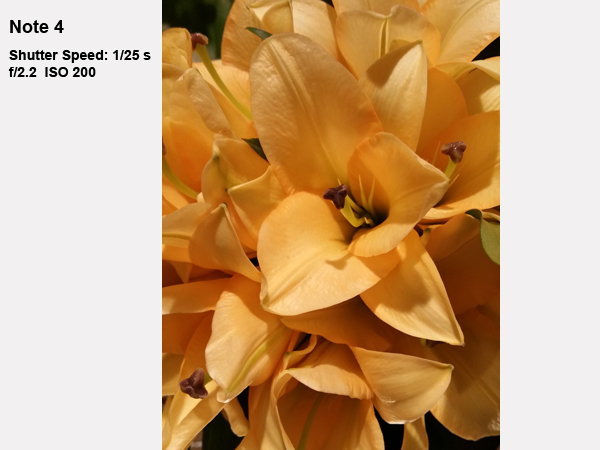
Full Size Images: iPhone 6 Plus, iPhone 5s, Galaxy Note 4
This picture of a flower was taken indoors, without natural light, in the lobby of a hotel. As expected, the images from both the iPhone 5s and 6 Plus are nearly identical. The color balance looks correct, but they look a little dark.
Also note that the 6 Plus was able to hold its shutter open twice as long and use a lower ISO setting thanks to the stabilization provided by OIS. The ability to use a lower ISO setting has the potential to reduce noise in the image.
The color balance on the Note 4 skews too far into the red. While this makes the flower petals’ color look more saturated, the green in the leaves and styles is a bit off.
Get Tom's Hardware's best news and in-depth reviews, straight to your inbox.

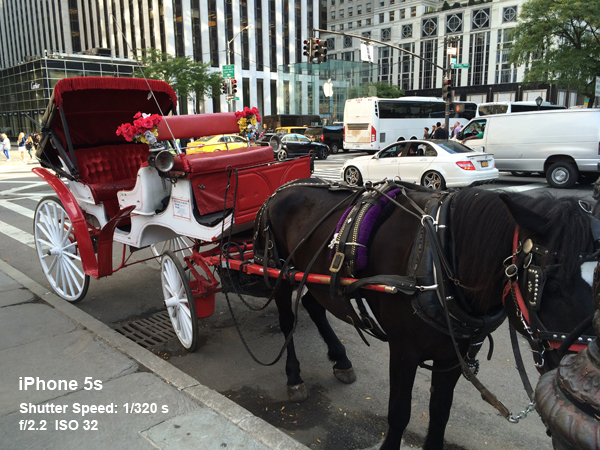

Full Size Images: iPhone 6 Plus, iPhone 5s, Galaxy Note 4
In this outdoor scene with some shadows, the 6 Plus holds its shutter open longer and creates an overall brighter image. Unfortunately, the OIS doesn’t fully compensate for my shaky hand and the image comes out a bit blurry (it’s more pronounced in the background). It also looks like the 6 Plus applied some tonal mapping to reduce reflections on the rear fender as discussed in the linked article above.
The image produced by the Note 4 is impressive, with nearly perfect exposure and white balance. Zooming in, we can see the advantage of having a sensor with twice as many pixels, as there’s far less aliasing along edges and objects in the background retain much more detail.
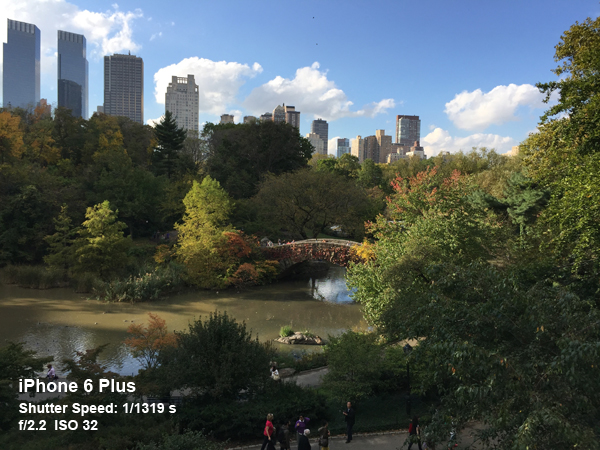
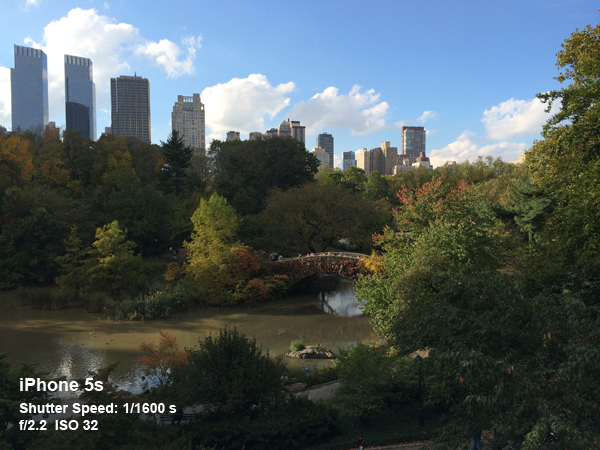

Full Size Images: iPhone 6 Plus, iPhone 5s, Galaxy Note 4
This outdoor scene was taken in Central Park under more challenging lighting conditions. The foreground is in heavy shadow, while the pond and sky are brightly lit. This shot would definitely benefit from using the high dynamic range (HDR) feature, but while HDR was set to automatic for each device, the iPhone cameras didn’t use it. The Note 4 does appear to use HDR even though the image metadata says it didn’t.
The image taken by the 6 Plus is a little brighter than the one from the iPhone 5s, but otherwise they’re essentially the same. The image from the Note 4 is markedly different, though. The dark shadows are nearly eliminated, brightening up the entire scene. The blue sky gets a little washed out but otherwise the image is pleasing to the eye. You could argue that the iPhone images more accurately capture the scene, but ultimately I prefer the image from the Note 4.
Zooming into the full-size images, the Note 4’s higher resolution really shines. The leaves and branches in the foreground trees are better-defined, and the you can discern the faces of people standing on the bridge. The Note 4 even captures the individual elements of the fence just behind the bridge, versus a smeared shadow from the iPhones.
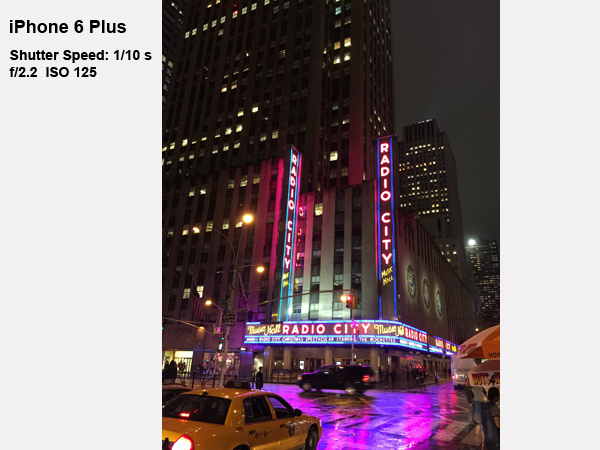


Full Size Images: iPhone 6 Plus, iPhone 5s, Galaxy Note 4
In this night shot, the 6 Plus shows less noise in the dark sky than both the iPhone 5s and Note 4. However, the Note 4 shows less noise on foreground objects like the front of the building. Looking at the reflection on the wet street, we see a weird noise pattern from both iPhones that’s not present in the Note 4 image. This could be caused by the noise reduction algorithm used in post-processing by the iPhone.
Once again, both iPhones do well with color accuracy. The Note 4 puts a little too much emphasis on yellow, giving the gray building a slightly yellow cast and oversaturating the street lights.
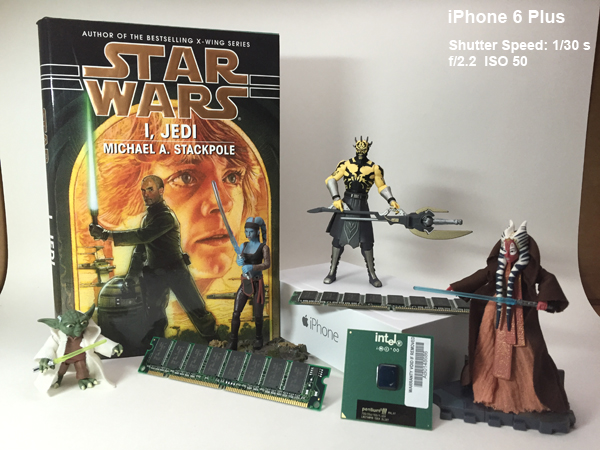


Full Size Images: iPhone 6 Plus, iPhone 5s, Galaxy Note 4
The next three photos examine low light performance in a controlled setting. This first image is a baseline using some cool fluorescent lights and overhead incandescent bulbs. The Note 4, while a little dark, produces the superior image. Both iPhone images lack contrast and have a yellow tint. Objects in the Note 4 image are also much crisper. The iPhone’s lack of resolution and over-aggressive noise reduction makes objects in its images far more indistinct.



Full Size Images: iPhone 6 Plus, iPhone 5s, Galaxy Note 4
In this challenging low-light shot, the 6 Plus has far less noise than the iPhone 5s. It does this by keeping ISO at only 250 compared to the 5s’ ISO of 1000. With a lower sensitivity, the 6 Plus holds its shutter open longer to capture more light and relies on OIS to stave off camera shake-induced blur. The 6 Plus relies heavily on this strategy, so much so that it only supports up to ISO 500. The iPhone 6, without OIS, supports up to ISO 2000. In general, raising ISO increases noise, so the 6 Plus, shooting at a lower ISO, handles low-light settings better than the iPhone 6.
The Note 4 didn’t record any metadata for this image, but we can easily see it’s darker overall than the image from the 6 Plus and also has more background noise.



Full Size Images: iPhone 6 Plus, iPhone 5s, Galaxy Note 4
Now we’re using the same ambient lighting as in the low-light pictures, but we turn on the camera’s flash. Again, the 6 Plus produces a better image than the iPhone 5s, being brighter and with less noise. It’s far from perfect, however, as the color is a bit too warm and the picture lacks contrast. At a distance of only a couple feet, the light from the flash is too concentrated on the middle of the image, making the center too bright and leaving the edges dark. This situation improves as you move further from the subject and allow the light cone to spread out more.
The Note 4 does very well with its flash turned on. While the image is darker than the one from the 6 Plus, the light from its flash is more evenly distributed. The color balance and contrast are also excellent. With more light, the Note 4 captures additional detail, but with a bit more noise than the 6 Plus.
Camera Performance
Shot-to-shot performance on the iPhone 6 and 6 Plus, like that on the iPhone 5s, is nearly instantaneous. Even with HDR turned on it only takes around a half a second to process each image. Performance and the overall user experience is further improved by PDAF. While the iPhone 5s takes between 1-2 seconds to refocus every time the camera moves, and has trouble maintaining a focus lock in low-light conditions, the iPhone 6 manages to focus in near real-time and no longer struggles with focus lock. The speed is truly impressive and it makes taking pictures with the iPhone more enjoyable.
In terms of image quality, there are more similarities than differences between the iPhone 6, 6 Plus and 5s. For most conditions, all three produce comparable pictures. The biggest difference occurs in low-light conditions, where the 6 Plus can use OIS to keep the shutter open longer, reducing ISO and, thus, noise.
It wasn’t that long ago that the iPhone set the standard for image quality in phone cameras. However, Apple has failed to keep pace with the rapid advancements made by other companies. And while the iPhone camera is still quite good, it’s no longer the best. Image quality suffers primarily from a lack of resolution for both the front and rear cameras, resulting in pictures that can’t match the sharpness and detail shown by competitors like the Note 4 above. Apple also needs to fix the post-processing aberrations that have crept into iOS 8 affecting white balance and tone mapping, among other things.
Current page: Camera: Photo Quality
Prev Page Camera: Hardware And Software Next Page Camera: Video Quality